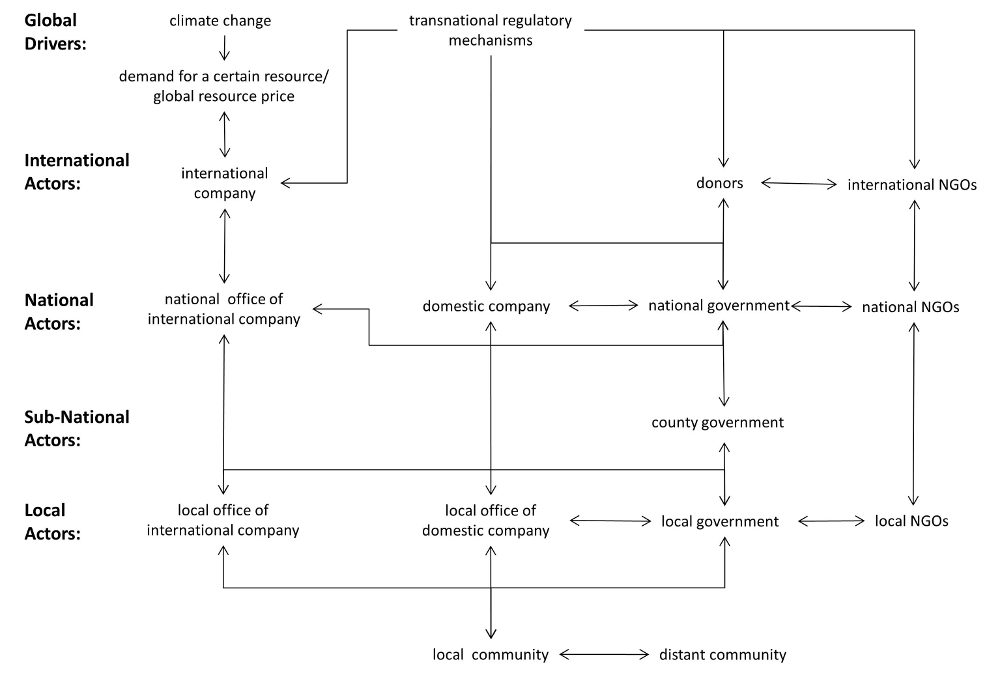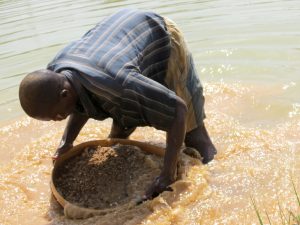by Janpeter Schilling1, Christina Saulich2 & Nina Engwicht3
How do global schemes of resource certification and global demand for valuable resources like diamonds and land influence local conflicts? How do local resource and conflict dynamics influence global processes related to resource demand and certification? To address these questions, we have edited a special issue in the journal Conflict, Security and Development that introduces a local to global framework to examine resource governance and conflicts across scales.
The framework is based on a review and synthesis of the literatures on the resource curse, environmental security and land grabbing. A common weakness of the three bodies of literature is a limited understanding of the local level. We hence suggest to start at the local level with an analysis of the relevant resource governance and conflict actors before looking at the national, international and global level – see image below.
Specifically, the framework first explores central resource and conflict dimensions as well as key local actors including their motivations and capabilities. It exposes differences, overlaps and interlinkages between actors of governance and conflict who often appear in more than one role and have diverse interests.

In a second step, the framework extends its focus vertically to include relevant actors and processes above the local level. This helps to examine and understand actor relations from the local to the global level. Specifically, it teases out how dynamics on the local level influence processes and actors at other sub-national levels (e.g. county government), the national level (e.g. central government, domestic companies, national non-governmental organisations), the international level (e.g. headquarters of international companies, international donors, intergovernmental organisations), and the global level (e.g. climate change, global demand for goods, international regulatory mechanisms).
Lastly, we suggest to start at the global level and move down, specifically to examine how actors at the global, international and national levels affect local conflict actors and resource dynamics. This dual process of local to global and global to local is helpful in identifying entry points for conflict mitigation strategies.
While this might all sound good in theory, what does that mean in practice? The special issue includes five articles that apply the local to global framework to case studies in Sub‐Saharan Africa, Latin America and Southeast Asia. Let us look at two key findings.
The majority of community members have limited opportunities to influence resource governance
The first finding is that international and national companies often work hand in hand with the national government to extract resources. Consequently, on the local level, some elites benefit while the majority of community members have limited opportunities to influence resource governance. They remain mostly excluded from the benefits and exposed to the negative effects of the resource extraction.
In Cambodia, for instance, a European company set up a large rubber plantation after the national government allocated a concession to the investor. The local communities were unable to resist the dispossession mainly for the lack of social coherence within the communities after years of civil war and displacement. Similarly, the national government of Ethiopia declared the land used by pastoral communities in the Maji area as ‘empty’ and then invited investors to lease the land. This led to violent conflict between government forces and pastoral groups. In north-western Kenya the conflicts between oil companies and local communities are less driven by the exclusion from land but rather by the perceived exclusion of local communities from employment opportunities in the oil sector.

(© Nina Engwicht)
Both in Ethiopia and Kenya, these conflicts overlapped with pre-existing local violent conflicts. Therefore, when the companies entered their area, the communities used the capabilities (experience, manpower, weapons, attack tactics) developed during the intercommunal conflicts to resist the investors and to realise their demands. In Kenya, for instance, community members blocked access roads to oil sites in order to increase the percentage of local employment.
The second finding suggests that global schemes of resource certification have ambivalent effects on local communities. In Costa Rica, the global programme ‘Reducing Emissions from Deforestation and Forest Degradation’ (REDD+) has the potential to create conflict between actors who want to preserve forests for climate protection, such as the national government, and local communities who need the forests for their livelihoods. On the other hand, REDD+ offered a platform for indigenous peoples to engage in a permanent dialogue with the national government.
Global schemes of resource certification have ambivalent local effects
In Sierra Leone, a global scheme to certify diamonds has not been fully implemented regarding the governance of the diamond market because local elites were able to prevent full institutional change. However, the certification scheme has helped to reduce harassment, extortion and violence against impoverished illegal miners and traders.
The examples show that local resource and conflict dynamics need to be analysed to understand how the global demand for resources such as land and oil as well as global certification schemes for forests and diamonds can influence the local level and vice versa. Based on this understanding it is possible for organisations and governments to identify scale-specific entry points for conflict prevention and mitigation strategies. What these may look like is detailed in the special issue which is freely available.
About the authors

Janpeter Schilling is a member of the editorial board of the blog Resources and Conflict. Janpeter holds a Klaus Töpfer Junior Professorship for Landuse Conflicts at the University of Koblenz-Landau. He is the managing director of the Peace Academy Rhineland- Palatinate. His research focuses on conflict, resources and resilience.

Christina Saulich is a researcher and project co-ordinator at Hochschule für Technik und Wirtschaft Berlin. From 2014 to 2016 she worked as a researcher and lecturer at the University of Koblenz-Landau. Her research centres on the areas of development studies and peace and conflict studies with a focus on sub-Saharan Africa.

Nina Engwicht is a post-doctoral researcher at the Peace Academy Rhineland-Palatinate at the University of Koblenz-Landau, Germany. In her work she focuses on natural resource economies in the transition from war to peace.
